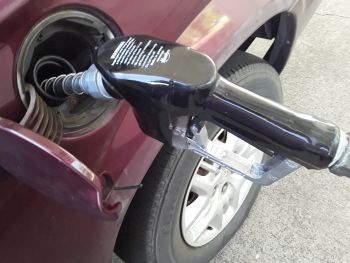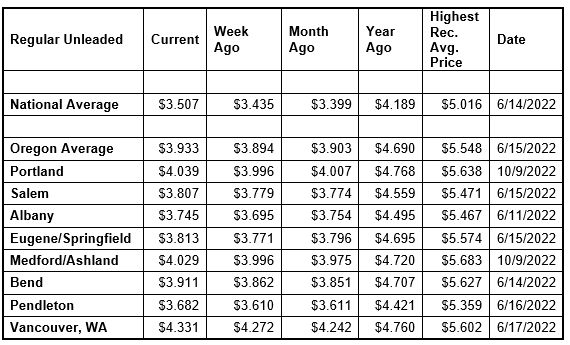
Publisher:
Bonnie King
CONTACT:
Newsroom@Salem-news.com
Advertising:
Adsales@Salem-news.com

~Truth~
~Justice~
~Peace~
TJP
Apr-04-2023 13:12

 TweetFollow @OregonNews
TweetFollow @OregonNews
OPEC Cuts Production Pushing Pump Prices Higher
Salem-News.comRising oil prices & demand for gas means higher prices at the pump
 Photo by Bonnie King Salem-News.com |
(PORTLAND, Ore.) - A surprise announcement by OPEC+ to cut oil production has sent crude oil prices soaring above $80 per barrel. That along with robust demand for gas in the U.S. are pushing pump prices higher.
For the week, the national average for regular unleaded climbs seven cents to $3.51 a gallon. The Oregon average adds four cents to $3.93.
On Sunday, the Organization of the Petroleum Exporting Countries and other major oil producers, including Russia, known collectively as OPEC+, announced a voluntary agreement to slash their output by just over 1 million b/d through the end of 2023.
The cut is planned to start in a month. The move caused oil prices to spike, popping over the $80 per barrel mark. This will pull up pump prices when they were already expected to rise due to higher demand during the summer driving season.
“The move by OPEC+ and increasing demand for gas in the U.S. mean drivers will pay more to fill up,” says Marie Dodds, public affairs director for AAA Oregon/Idaho.
“However, if recessionary concerns persist in the market, oil price increases may be limited due to the market believing lower oil demand will lead to lower prices this year.”
Crude oil prices shot up above $80 per barrel on Monday, the first time crude climbed above $80 since March 6.
Crude oil continues to trade around $80 today compared to $73 a week ago and $103 a year ago. In March, West Texas Intermediate ranged between about $64 and $81 per barrel. In February, WTI ranged between about $73 and $80 per barrel.
In January, WTI ranged between about $73 and $82 bbl. Crude reached recent highs of $123.70 on March 8, 2022, shortly after the Russian invasion of Ukraine, and $122.11 per barrel on June 8, 2022. The all-time high for WTI crude oil is $147.27 in July 2008.
Crude oil is the main ingredient in gasoline and diesel, so pump prices are impacted by crude prices on the global markets.
On average, about 56% of what we pay for in a gallon of gasoline is for the price of crude oil, 20% is refining, 11% distribution and marketing, and 14% are taxes, according to the U.S. Energy Information Administration.
Another factor putting upward pressure on pump prices this time of year is the seasonal switch to summer-blend fuel.
 California has an April 1 deadline to switch to summer-blend fuel, while the federally mandated deadline is May 1.
California has an April 1 deadline to switch to summer-blend fuel, while the federally mandated deadline is May 1.
The West Coast region often sees prices climb earlier than other parts of the country because of that earlier California deadline. More info on summer- and winter-blend gasoline can be found at the EPA website.
Demand for gasoline in the U.S. demand increased from 8.96 million to 9.15 million b/d for the week ending March 24. Meanwhile, total domestic gasoline stocks decreased substantially by 2.9 million bbl to 226.7 million bbl.
Increased demand amid tighter supply has contributed to pushing pump prices higher. If demand continues to rise, pump prices will likely follow suit.
Quick stats
Oregon is one of 44 states and the District of Columbia with higher prices now than a week ago. Ohio (+21 cents) has the largest weekly jump. Colorado (-10 cents) has the largest week-over-week drop.California ($4.85) has the most expensive gas in the nation for the fifth week in a row. Hawaii ($4.79) is second, Washington ($4.32) is third, Arizona ($4.31 is fourth and Nevada ($4.22) is fifth.
These are the only five states with averages at or above $4 a gallon. This week 45 states and the District of Columbia have averages in the $3-range. No states have averages in the $2 range this week, same as a week ago.
The cheapest gas in the nation is in Mississippi ($3.02) and Arkansas ($3.09). For the 116th week in a row, no state has an average below $2 a gallon.
The difference between the most expensive and least expensive states is $1.82 this week, same as a week ago.
Oregon is one of 34 states and the District of Columbia with higher prices now than a month ago. The national average is 11 cents more and the Oregon average is three cents more than a month ago.
This is the smallest monthly increase in the nation. Arizona (+63 cents) has the largest monthly jump. Colorado (-52 cents) has the largest monthly decline.
All 50 states and the District of Columbia have lower prices now than a year ago. The national average is 68 cents less and the Oregon average is 76 cents less than a year ago. California (-$1.01) has the largest yearly drops.
A year ago, pump prices were rising rapidly after the start of the Russian invasion of Ukraine.
West Coast
The West Coast region continues to have the most expensive pump prices in the nation with all seven states in the top 10. It’s typical for the West Coast to have six or seven states in the top 10 as this region tends to consistently have fairly tight supplies, consuming about as much gasoline as is produced.In addition, this region is located relatively far from parts of the country where oil drilling, production and refining occurs, so transportation costs are higher. And environmental programs in this region add to the cost of production, storage and distribution.
California has the most expensive gas in the nation for the fifth week in a row. Hawaii Washington, Arizona, Nevada, and Oregon round out the top six. Alaska is eighth. Oregon is sixth for the eighth week in a row.
All states in the West Coast region are seeing small to moderate changes on the week. Arizona (+7 cents) has the largest increase in the region. Hawaii (-2 cents) is the only state in the region with a weekly decline.
The refinery utilization rate on the West Coast fell from 87.2% to 86.0% for the week ending March 24. This rate has ranged between about 73% to 93% in the last year. The latest national refinery utilization rate is 90.3%.
According to EIA’s latest weekly report, total gas stocks in the region increased from 29.69 million bbl. to30.12 million bbl.
A lower refinery utilization rate can put upward pressure on pump prices, while an increase in gasoline stocks can put downward pressure on pump prices.
Oil market dynamics
Crude prices shot up to start this week after the announcement from OPEC+ on Sunday that the cartel would cut oil production by about a million barrels a day starting in May.Crude prices had been in the mid-$60 to mid-$70 range for the last month. Additionally, the EIA reported that total domestic commercial crude inventories decreased by 7.5 million bbl to 473.7 million bbl last week.
At the close of Friday’s formal trading session, WTI added $1.30 to settle at $75.67. At the close of Monday’s formal trading session, WTI added $4.75 to close at $80.42.
Today crude is trading around $80, compared to $73 a week ago. Crude prices are about $19 less than a year ago.
Drivers can find current gas prices along their route with the free AAA Mobile app for iPhone, iPad and Android.
The app can also be used to map a route, find discounts, book a hotel and access AAA roadside assistance. Learn more at AAA.com/mobile.
Diesel
For the week, the national average dips three cents to $4.21 a gallon. The record high is $5.816 set on June 19, 2022. The Oregon average slips two cents to $4.64. The record high is $6.47 set on July 3, 2022. A year ago the national average for diesel was $5.09 and the Oregon average was $5.43.Source: AAA/Oregon
Articles for April 3, 2023 | Articles for April 4, 2023 |


googlec507860f6901db00.html
Quick Links
DINING
Willamette UniversityGoudy Commons Cafe
Dine on the Queen
Willamette Queen Sternwheeler
MUST SEE SALEM
Oregon Capitol ToursCapitol History Gateway
Willamette River Ride
Willamette Queen Sternwheeler
Historic Home Tours:
Deepwood Museum
The Bush House
Gaiety Hollow Garden
AUCTIONS - APPRAISALS
Auction Masters & AppraisalsCONSTRUCTION SERVICES
Roofing and ContractingSheridan, Ore.
ONLINE SHOPPING
Special Occasion DressesAdvertise with Salem-News
Contact:AdSales@Salem-News.com


Terms of Service | Privacy Policy
All comments and messages are approved by people and self promotional links or unacceptable comments are denied.
[Return to Top]
©2025 Salem-News.com. All opinions expressed in this article are those of the author and do not necessarily reflect those of Salem-News.com.